Saving the American Chestnut tree

Since 1983, The American Chestnut Foundation (TACF) has been working to restore the iconic American chestnut to its native forests along the eastern United States. Through scientific research and a combination of traditional breeding and biotechnology, TACF has made significant progress over the past three decades. Progress you can see firsthand at Sky Meadows State Park.
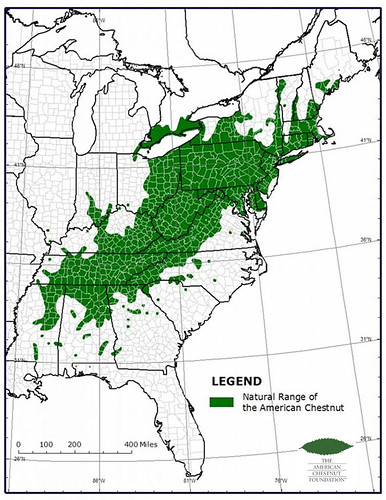
American chestnut native range, map courtesy of The American Chestnut Foundation
What happened to the American chestnut?
The American chestnut used to be a dominant and crucial species in the eastern forests of North America. However, in the early 20th century, a devastating fungal disease known as chestnut blight was accidentally introduced to the United States. The blight, originating from Asia, rapidly spread and destroyed the American chestnut population.
The fungus causes cankers on the trees that grow, girdle and kill branches and trunks. Within a few decades, the blight effectively wiped out an estimated 4 billion American chestnut trees.
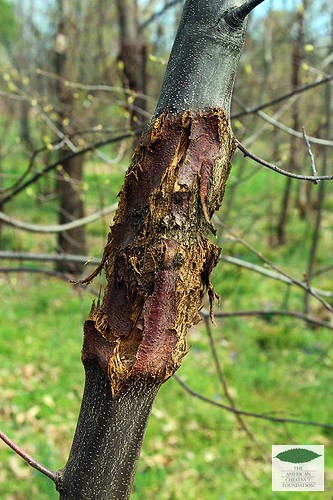
Chestnut blight, photo courtesy of The American Chestnut Foundation
How is TACF restoring the American chestnut?
Efforts to save the American chestnut include genetic modification, reducing the severity of blight and traditional breeding to develop a blight-resistant American chestnut tree.
At TACF, many staff and volunteers are involved in the traditional breeding method, creating hybrid trees that combine the blight resistance of the Chinese chestnut with the timber-type form of the American chestnut.
TACF has tens of thousands of trees at various stages of the breeding process planted at its Meadowview Research Farms in Meadowview, Virginia. The foundation has taken some of the most blight-resistant hybrids from the Research Farms and planted them in more than 40 restoration trails in the eastern U.S. to test their blight resistance and competitive ability.
In addition to the hybrids planted along the restoration trails and Research Farms, TACF has several seed orchards, including three in the Northern Virginia area at Blandy Experimental Farm, Banshee Reeks Nature Preserve and Sky Meadows State Park.
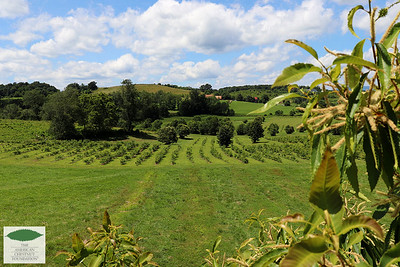
Meadowview Research Farms, photo courtesy of The American Chestnut Foundation
Partnering with Sky Meadows State Park
In 2018, members of TACF identified Sky Meadows as a possible site for an American chestnut seed orchard. The park already had two Chinese chestnut trees growing outside its gift shop and drained acidic loamy soil, making it an ideal location.
For Sky Meadows, this project aligned with the park’s mission to help preserve the rich natural diversity of the Crooked Run Valley and welcomed the opportunity to partner with TACF. So, work began to prepare the 4-acre site, including building an 8-foot deer fence, clearing brush and plowing and disking the land.
Once the site was ready, TACF started the planting process, which spans several years. Since this orchard is part of the foundation’s breeding program to produce more blight-resistant hybrid seeds, TACF breaks the orchard into plots and uses a different family of trees with a common grandmother tree in each plot.
The plots are planted when seeds for the desired families are available, and since trees vary in production from year to year, it takes a few years to get all the seeds. The end goal was to plant 5,700 seeds at Sky Meadows, so, if you visit the orchard, you’ll notice trees that range from 6 years old to trees that just sprouted.
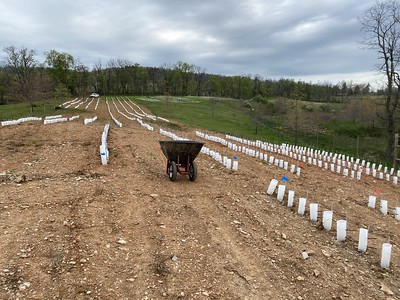
The early stages of an American chestnut plot at Sky Meadows State Park
Once the trees are 5 to 6 years old, the selection process to find the best of the best begins. In spring, TACF will inject the trees with the fungus that causes blight, and then, in fall, they return to see how the trees handled the blight.
At that point, the trees are rated 1 to 3, with 1 being the most resistant and 3 being the least resistant. Any tree that has a rating of less than 2 will be kept. TACF will re-evaluate the trees every fall until they get the six best trees from each family.
TACF plants at a high density so that 26 trees per acre are likely to remain after the selection process. The foundation uses an initial spacing of 1 foot by 7 feet, which is as tight as the seedlings can be planted before thinning. This is a proven acceptable practice for seed orchards.
While TACF says the orchard is progressing well right now, it’s faced its fair share of challenges since 2018. The newest round of plantings was hit hard by drought last year, and the main ongoing issue is vines trying to strangle the trees. One of the most prominent vines is poison ivy, which also poses a health hazard to TACF’s volunteers and discourages weeding efforts.
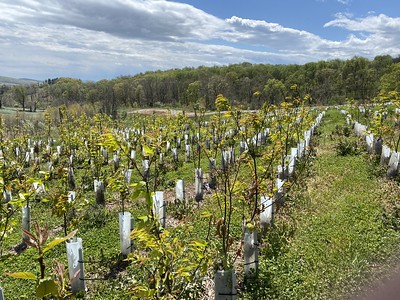
An American chestnut plot at Sky Meadows
What happens next?
The selection process to find the six trees from each family with the most blight resistance will likely take another 6 to 10 years. The final selection of trees from Sky Meadows will be bred with each other and possibly other trees that made it to the final selection from the orchards at Blandy Experimental Farm and Banshee Reeks Nature Preserve. Between all three orchards, there will be 108 trees remaining after the selection process.
Eventually, the nuts from these 108 trees will be used for restoration efforts in forests and reclaimed mining lands. The exact timeline for these efforts is uncertain due to several factors, such as the selection process and studies of planting test sites, but TACF hopes to have some restoration projects going within 10 years.
So, while we won’t see the impacts of the three Northern Virginia orchards overnight, there’s no doubt that they’re playing a major role in helping The American Chestnut Foundation achieve its mission to save the iconic species, enhancing biodiversity, reinvigorating forest ecosystems and honoring a symbol of the American landscape.
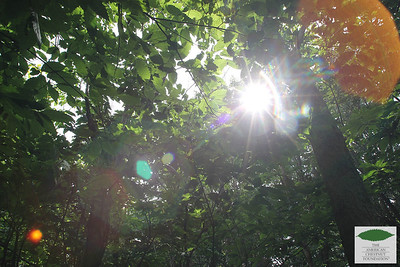
Canopy of hybrid American chestnut trees, photo courtesy of The American Chestnut Foundation
If you want to see the progress of the American chestnut orchard at Sky Meadows, we invite you to start planning your visit today by going to virginiastateparks.gov/sky-meadows.
To learn more about The American Chestnut Foundation, go to tacf.org.


